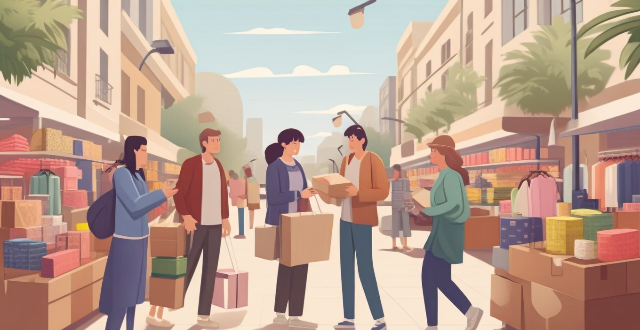Technology has revolutionized global shopping by increasing accessibility, personalizing experiences, enhancing payment options, integrating social media, and using AR/VR. It has also improved sustainability, logistics, customer service, and is set to transform the future of retail through IoT and experiential retail.

How Technology Has Revolutionized Global Shopping Experiences
Technology has had a profound impact on the way people shop around the world. From online marketplaces to mobile applications, technological advancements have transformed the global shopping landscape in numerous ways. Here are some key areas where technology has made a significant difference:
Increased Accessibility and Convenience
Online Marketplaces
- Amazon: A pioneering e-commerce platform that offers millions of products worldwide.
- Alibaba: A Chinese e-commerce giant that connects buyers and sellers globally.
- eBay: An online auction and shopping website where people can buy and sell goods.
Mobile Applications
- Shopify: A platform that allows merchants to create their own online stores.
- WooCommerce: A plugin for WordPress that turns websites into e-commerce stores.
- Magento: An open-source e-commerce platform used by businesses of all sizes.
Personalization and Customization
Artificial Intelligence and Machine Learning
- Product Recommendations: AI algorithms analyze user behavior to suggest relevant products.
- Chatbots: Automated assistants that help customers find what they need quickly.
- Virtual Try-On: AR technology allows customers to see how clothes or accessories would look on them before purchasing.
Data Analytics
- Consumer Behavior Analysis: Tracking user preferences to improve product offerings and marketing strategies.
- Inventory Management: Predictive analytics helps retailers manage stock levels more efficiently.
- Pricing Optimization: Dynamic pricing based on demand and competition.
Enhanced Payment Options
Digital Wallets
- Apple Pay: A mobile payment system that allows users to make payments using their Apple devices.
- Google Wallet: A similar service provided by Google for Android users.
- WeChat Pay & Alipay: Popular mobile payment solutions in China that offer seamless transactions.
Cryptocurrencies
- Bitcoin: The first decentralized digital currency, accepted by some retailers as payment.
- Ethereum: Another cryptocurrency with smart contract capabilities.
- Crypto Exchanges: Platforms like Coinbase and Binance allow users to trade cryptocurrencies easily.
Social Media Integration
Influencer Marketing
- Instagram Shopping: Allows users to purchase products directly from posts made by influencers or brands.
- Facebook Marketplace: A platform within Facebook where people can buy and sell items locally.
- TikTok For Business: A tool for marketers to run ads and partner with influencers for product promotion.
Augmented Reality (AR) and Virtual Reality (VR)
Virtual Try-On and Showrooms
- IKEA Place: An app that uses AR to let customers preview furniture in their homes before buying.
- Sephora Virtual Artist: An AR feature that lets customers try on makeup virtually.
- VR Store Tours: Some retailers offer VR experiences that simulate walking through a physical store.
Sustainability and Ethical Sourcing
Blockchain Technology
- Supply Chain Transparency: Blockchain can track products from origin to consumer, ensuring ethical sourcing.
- Counterfeit Goods Prevention: Verifying authenticity through immutable ledgers.
- Sustainable Practices: Technology aids in reducing waste by optimizing production processes.
Logistics and Delivery Innovations
Drone Deliveries
- Amazon Prime Air: A service that aims to deliver packages via drone within 30 minutes.
- Zipline: A company specializing in medical supply delivery via drone, with potential applications for retail.
- Flytrex: A drone delivery service operating in Iceland and North Carolina.
Automated Warehouses
- Robotic Pickers: Machines that retrieve items from warehouse shelves faster than humans.
- Automated Sorting Systems: Advanced conveyor belts sort packages efficiently.
- Driverless Vehicles: Self-driving trucks could revolutionize long-distance shipping.
Customer Service and Support
Live Chat Support
- Olark: A live chat software that integrates with websites to provide real-time customer support.
- Intercom: A comprehensive customer support platform that includes live chat features.
- Zendesk: A widely used customer service software suite with live chat capabilities.
Voice Assistants
- Amazon Echo: Powered by Alexa, it allows voice control for various tasks, including shopping.
- Google Home: Similarly, it uses Google Assistant for voice commands related to shopping.
- Apple HomePod: Integrates with Siri for voice-activated shopping experiences.
Future Trends and Predictions
Internet of Things (IoT)
- Smart Home Integration: Devices like smart fridges could order groceries when supplies run low.
- Wearable Technology: Wearables could suggest clothing purchases based on activity levels or weather changes.
- Home Delivery Boxes: Lockers installed outside homes for secure package deliveries when no one is home.
Experiential Retail
- Virtual Fitting Rooms: Advanced AR technology could allow customers to try on clothes without physically changing.
- Interactive Storefronts: Touchscreens and interactive displays enhance the in-store experience.
- Gamified Shopping: Turning shopping into a game could increase engagement and loyalty.
In conclusion, technology has not only revolutionized global shopping experiences but also continues to shape the future of retail. As these trends evolve, consumers can expect even more convenient, personalized, and enjoyable shopping experiences across the globe.